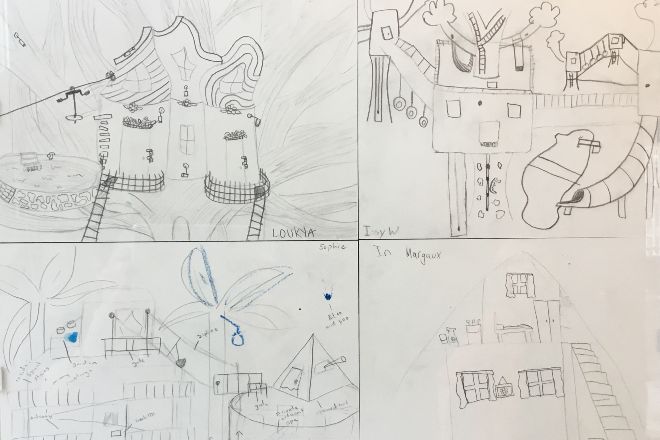Feature image: Plans for a new "Friendship Forest" playground at Stuart Country Day School of the Sacred Heart, developed by its fourth-grade students.
Students at the all-girls preschool-grade 12 Stuart Country Day School of the Sacred Heart in Princeton, New Jersey, are encouraged to think and act independently. They often come to faculty with their ideas for everything from getting a better playground to fixing the temperature in rooms that are too cold to improving indoor air quality. Rather than listening and saying, “We’ll see” or “We’ll take it under consideration,” Darren Malone, director of facilities and sustainable planning, began to research ways that students could be part of the solution to what the school refers to as their “wonderings.” Malone along with Rose Neubert, director of finance and operations, and Courtney Portlock, head of upper school, explained the the development of the program in a recent NBOA webinar.
Think Global. Act Local.
Malone researched a program called “campus as lab” — essentially, using your school’s plant as a microcosm of the larger world and having students participate in solving real-world problems close to home using data. Along the way, students learn to do research and analyze data, work collaboratively and see the impact of their ideas. The school itself also benefits from the data collected, among other things.
The campus-as-lab community includes 128 schools across the U.S. and Canada, and Stuart Country Day is currently the only independent school in the mix.
SCD’s program, which began about three years ago, is called Labatut’s Learning Lab. It was named after Jean Labatut, a distinguished architect and professor at Princeton University, who designed SCD’s campus in 1963. Labatut died in 1986 at age 87. Interestingly, he also designed Princeton's architectural laboratory, where, beginning in 1949, studies were conducted on the effects of climate and environment on building materials. “Our respect for Labatut's impact on Stuart and his legacy as a teacher inspired us to name our campus as a lab program [after him],” Malone said.
During his research, Malone discovered a campus-as-lab program at nearby Princeton University, which he visited to learn how the program worked. Soon, SCD joined a campus-as-lab community made up of 128 institutions across the United States and Canada. Located on 55 acres and with 450 students, SCD is the only independent school in the mix.
Inspiration and Engagement
Campus-as-lab is all about project-based learning. “We want to make the process as important if not more important, than the outcome,” Malone said. And in forming that process, “you need to think about the ways you can build a bridge between academics and operations.”
All of a sudden, the students are incredibly engaged in raw data because it's relevant to their experience here on campus and the spaces that they know and in some cases love or don't like because it's freezing cold in there.
Darren Malone
Stuart Country Day School
of the Sacred Heart
The school gives students a template of sorts that helps them work their way through a project, with questions such as, What is the scope of work that needs to be done? What do I need to be figuring out and finding out? Who needs to be involved? Which departments? Which areas of the school? How is it that I'm going to navigate those relationships? How is it that we're going to actually make this project come to fruition? What is the budget? What are the funding sources available to us?
For example, elementary students wanted a playground. “Rather than [have] the facilities department demolish and just replace [it], we engaged the fourth grade through one of their service-learning projects to design a project” said Malone. “That design project was to consider what the ‘Friendship Forest’ playhouse should be in the future, how it would support the programming and the needs of the students and then to actually go through a design process as though they were a group of 9- and 10-year-old architects.”
This video show models for the The Friendship Forest Pavilion developed by Stuart Country Day's fourth grade class
So far, the students have developed a design program and a series of studies. Malone said they will soon start to “work with outside architects to develop the actual drawings that would make those design ideas and that program come to life.”
In another project, older students used data gathered from the school’s building-control dashboard — which accesses 2,500 points of data including building energy information, room temperature, occupancy, CO2 levels and relative humidity. “All of that data is trendable, and it's accessible to our students and to our faculty,” Malone said. The students used the data to compare temperatures in rooms in two areas of one of the school’s buildings. “All of a sudden, the students are incredibly engaged in raw data because it's relevant to their experience here on campus and the spaces that they know and in some cases love or don't like because it's freezing cold in there,” Malone said.
The hope is that the program will “inspire [students] to wonder, to be curious, to tinker, to really discover ways to see the school environment from their classrooms, the hallways, the playgrounds, the stream — all of it as an opportunity to learn and grow,” said Courtney Portlock, head of upper school and director, National Center for Girls' Leadership at Stuart.
Sounds like they’re on their way.
For more information on the program, NBOA members can visit the webinar archive.



